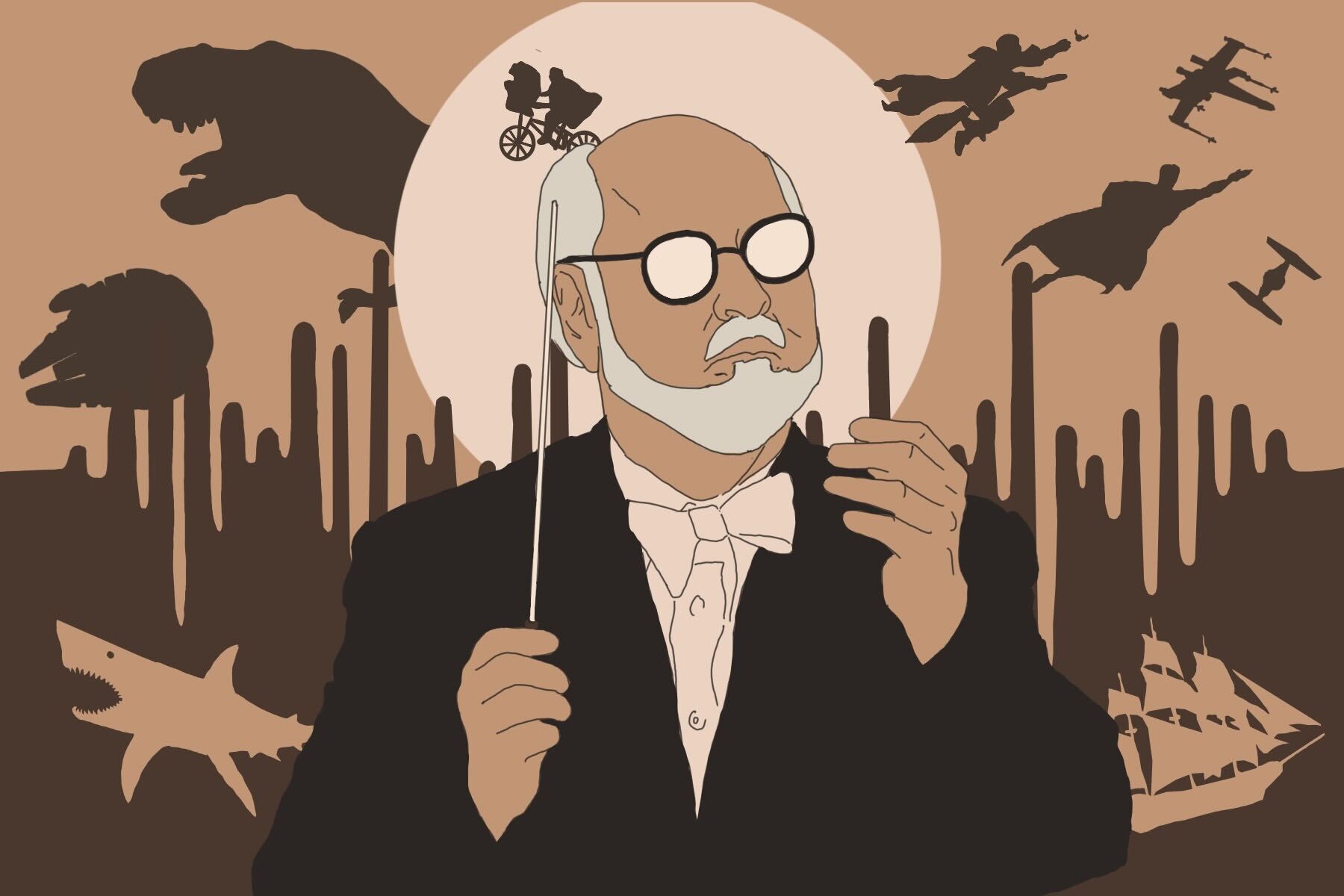There are few films that start with as much excitement as the original “Star Wars.” A now-legendary sequence of title cards and production company titles comprise the film’s first two minutes, an opening that is seared into pop culture immortality. Following the classic 20th Century Fox production logo, the simple green font of the Lucasfilm Limited title card flashes onscreen. The dim blue hue of the text reading “A long time ago, in a galaxy far, far away…” appears for a brief second before slowly fading to black as the audience is filled with anticipation. Suddenly, in a burst of light, the title card of the movie appears and begins to scroll upward as the pre-film synopsis introduces the characters and conflicts of the fictional world. The sequence is pure movie magic, yet the most powerful element of the opening isn’t anywhere on the screen.
It is undoubtedly the triumphant music playing behind the “Star Wars” title crawl that has made the sequence a treasured part of cinematic history. The opening theme, and the franchise’s entire soundtrack, is the work of John Williams, arguably the movie world’s most prolific and accomplished musical mind. Known for his incredible compositional talents that allow him to convey emotion and add a rich atmosphere to a film, Williams has spent the last 70 years writing some of the most recognizable scores in cinema history.
Williams’ career as a film composer began in 1952 following his graduation from the renowned Eastman School of Music, yet he did not receive widespread acclaim until his early collaborations with a young Steven Spielberg in the 1970s. His rise to stardom soon followed, collaborating further with Spielberg throughout his career and crossing paths with the likes of George Lucas, John Hughes and Alfred Hitchcock. Wherever he ventured in the world of film, Williams always brought his patented ingenuity along with him, creating masterpiece after masterpiece.
Understanding how someone can generate dozens of melodies that seem to be synonymous with the movies they accompany is difficult. It is hard to imagine Williams’ music as anything short of a robust, complete musical vision, yet Williams is the first to note that his creative process is mostly trial and error, with great emphasis on the latter. Each project is radically different, yet Williams chooses to approach them by first internalizing the emotional tenor of the raw movie footage.
When asked about his process, Williams noted that: “If you read the script first, you form all kinds of preconceptions about how things look, what the location’s like, what the actors are like. And then you may look at what the director’s chosen — it doesn’t comport with your conceptions at all. On the other hand, if I have the luxury of going into the dark projection room and being surprised when the audience is surprised and being bored when they’re bored, I think that gives me a sense of what my job is…”
The ability to serve as the musical mouthpiece for the audience’s viewing experience is the role Williams aspires to with his writing process. Through a complex series of melodic experimentation, he oftentimes stumbles upon pieces that have the distinct ability to transform a scene. In a 2016 interview with French director Stéphane Denéve, Williams remarked that after much trial and error: “Finally, you get something, and you say ‘Ah, this is clear. This sounds like it belongs in this thing, it belongs to the film.’” The simple clarity with which Williams characterizes his eventual masterpieces does not fully capture the immense complexity of their textures and emotional connotations. It is hard to fully comprehend Williams’ creative process; it is downright impossible to replicate it.
An essential component of Williams’ skill is his ability to write music that captures the atmosphere of an environment that has never before been conceived or experienced. The majestic world of the dinosaurs in “Jurassic Park” is a prime example of this mastery. Williams began the process of writing the soundtrack by listening to the newly minted sound effects concocted for the computer-generated dinosaurs, noises that were also without precedent in film history.
The task before him was daunting: Conjure a soundscape that captures the feeling of discovering and encountering a world of species that no human has ever seen alive. The track titled “Welcome to Jurassic Park,” which plays over the first shot of several living brachiosauruses grazing in the park’s hills, is a rich, slow melody that uses a symphony of strings to convey the grandeur of the majestic creatures. It establishes a musical motif that is repeated later in the movie at moments of particular wonderment, bringing up the same feelings of otherworldly surprise that are imprinted upon the track when it is first played.
The movie also allowed Williams to demonstrate his ability to write music that captures fear, such as when the velociraptors chase the children through the park’s kitchen. The soundtrack quiets down to match the characters’ silence, yet it escalates and sharply cuts through the quiet when the raptors get closer to finding the children. The unresolved tension of the track marvelously captures the simultaneous fears of death and of the unknown, dynamics that are central to the film’s plot. The entire soundtrack is a precise mirroring of the film’s themes, amplifying emotions and sensation to create a gripping blockbuster experience.
Some films require soundtracks that capture fantastical moments in an otherworldly setting, yet some ask for music that captures a sense of wonderment within a more familiar environment. Steven Spielberg’s “E.T. the Extra Terrestrial” demonstrates this perfectly, using Williams’ score to emphasize the otherworldly enchantment occurring within a recognizable 1980s suburban milieu. The film’s most famous track, “Flying,” which plays during the scene where E.T. and Elliott fly through the evening sky on a bike, is a testament to Williams’ understanding of how human perception is linked to music.
Seeking to encapsulate the magical quality of rising into the sky on a bike, Williams wrote a simple melody in C major that conveys the excitement of the moment with an upbeat tempo. The sensation of lifting into the air is musically captured when the melody line repeats, ascending by a fifth, and subsequently by an octave on the second refrain. The audience can feel the parallel between the soundtrack and the visuals even if they are unaware of the precise compositional techniques at play. The music Williams writes operates on several levels and displays numerous compositional intricacies, yet it functions in a straightforward and understandable way. What the audience can feel informs its understanding of the film, and Williams is a true master of writing music overflowing with sensation and emotion.
Williams’ compositional genius is perhaps most often associated with the “Star Wars” series, the most prolific film franchise he has worked on. Each piece from the franchise has become embedded in pop culture and has defined and enhanced the memorable characters and stories that have made the franchise lucrative.
“Star Wars” is the best example of how Williams often does more than the screenwriter does to solidify the development of the onscreen characters. Darth Vader’s ominous stature as the franchise’s antagonist is synonymous with the thundering brass of “The Imperial March.” The modest wisdom of the Jedi Master Yoda is serenely echoed in his own subdued orchestral theme that flutters around his frequently quoted dialogue. The memorability of the film’s soundtrack is largely due to its versatility, covering a staggering amount of tonal ground within a few films.
The events of the space saga take place, as the title crawl says, “in a galaxy far, far away,” yet the subtext of the films is incredibly familiar. Loss, romance, discovery and triumph are the series’s key themes, and Williams conveys each of these in a manner that plays to the musical conventions the audience understands.
“Star Wars” is notable for the strong presence of brass and woodwind instruments, used heavily in early classical and operatic scores. The adventurous and dramatic connotations of the instrumentation carry over into the films’ soundtracks, bolstering the melodies that are played. Action scenes are punctuated by sudden tempo and volume changes, mirroring the rapidly changing nature of the onscreen battles and duels. Somber moments, such as the deaths of Yoda and Darth Vader, are framed with soft, slow melodies that reiterate the characters’ theme music developed earlier in the series.
Pitch and tempo are fundamental emotional signals that Williams experiments with throughout his discography to bridge the movie’s plot and the audience’s emotional response to music. “Star Wars” sees this demonstrated on one of the largest cinematic stages and has become the most loved science fantasy series because of Williams’ mastery.
There is nothing left for Williams to prove or accomplish after a 70-year career of compositional brilliance, and after recently completing the score for the upcoming “Indiana Jones” film, the now 90-years-old Williams announced his retirement. There is much to look back on and appreciate in his seven decades as a composer, yet his ability to completely transform the visceral emotional side of the moviegoing experience consistently rises to the top of his accolades. Denéve offers a particularly instrumental insight into the transformative effect of Williams’ soundscapes: “What I’ve found very fascinating is to sometimes see a scene of a movie without your music, and it can sound so empty and so meaningless or feelingless. And then, if we add your music, it is a totally different feel.”
Throughout his career, Williams took the art of movie soundtracks and transformed it from an entertaining sideshow to a fundamental component of filmmaking. The movies Williams has worked on are often remembered firstly for their music, and that accomplishment demonstrates a degree of personal influence few in Hollywood can match. Steven Spielberg, the man who has arguably had the most extensive creative partnership with Williams, is also one of his greatest admirers. Addressing the audience at the American Film Institute’s 44th Life Achievement Awards, Spielberg gave the greatest encapsulation of Williams’ unparalleled genius: “Without John Williams, bikes don’t fly, nor do brooms in Quidditch matches, nor do men in red capes. There is no Force. Dinosaurs do not walk the earth. We do not wonder, we do not weep, we do not believe.”

















